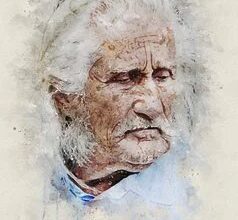The Bush Undertaker | Summary and Analysis
Summary of The Bush Undertaker by Henry Lawson

The short story “The Bush Undertaker” is taken from the collection While the Billy Boils. The story is told in the third person by an unknown narrator. Isolation, companionship, curiosity, happiness, survival, and control are some of the themes explored by Henry Lawson in the story. While the Billy Boils includes stories like Our Pipes and Settling on The Land, the summaries and analyses of which may be found in the link below:
Summary of Settling on The Land
The Bush Undertaker | Summary
The story opens with an elderly man preparing dinner for himself and his faithful companion, Five Bob. After finishing his meal, the man grabs a pick and shovel and heads to a “blackfellow’s grave,” which piques his interest. He gathers the bones, places them in a bag, and heads back to his house. He comes across a man’s body, burned from the harsh Australian sun. The deceased man is determined to be a friend of the old man, an alcoholic named Brummy, after a thorough examination. The old man devises a method of transporting Brummy back home, but he is startled by a swarm of enormous, greasy black goannas. He’s perplexed as to why strange lizards are so common nowadays. When he shoots one near the home, he realizes that they are attracted to Brummy’s body. When the old man gets home, he decides that Brummy deserves a dignified funeral. He buries his friend and realizes that he ought to say something. Brummy’s faith, if he has one at all, is unknown to him, but the old man does his best. As the sun sets on the “grand Australian bush,” he rises, gathers his tools, and walks back to his hut.
And the sun sank again on the grand Australian bush—the nurse and tutor of eccentric minds, the home of the weird.
The Bush Undertaker | Analysis
The tone of Lawson’s stories is simple and consistent. The story is modest and has a moderate level of tension. The narrative’s steady and the tone reflect the repetitive quality of bush life. It recreates a distinct feeling of the misery of his bush characters. They exist in a world where there is little hope for the future and where there is no escape from their daily responsibilities and routines. Lawson’s stories are structured to elicit interest and sympathy, but not sentimentality. This stands in stark contrast to classic, romantic Victorian authors, who were extensively read at the time Lawson’s works were published.
The harshness of their situations ultimately defeats Lawson’s characters. The protagonist of Henry Lawson’s “The Bush Undertaker” is eventually defeated by the savagery of his situation. Despite this, the character has considerable resiliency and makes every effort to overcome his obstacles. As a result of the circumstances in which he must live, Lawson’s characters suffer both bodily and psychological pain. Indicated quiet subtly it explores the relationship between eccentric and sane. Despite the actions of the shepherd claiming otherwise, he is kind.
The old man discloses that Brummy “uster say as how it ‘ud be alright termorrer”,
Later, he says that tomorrow has come for Brummy but not for him, meaning that he is looking forward to his death, which appears to be his incentive for working hard. “The Bush Undertaker” comes to a close with:
“he rose, took up the tools, and walked back to the hut”,
indicating that, despite his friend’s loss, he will continue to work till his death. In this way, despite his difficult circumstances, the elderly man might be considered unbeatable.
The story also discerns the idea of race. The graves of “blackfellows” represent the graves of the aboriginals.
“When he had raked up all the bones, he amused himself by putting them together on the grass and by speculating as to whether they had belonged to black or white, male or female. Failing, however, to arrive at any satisfactory conclusion, he dusted them with great care, put them in the bag, and started for home.”
In the 1890s, Lawson depicts objective, unemotional, and realistic depictions of the distinctively Australian situation. This method was part of a direct challenge to Imperial authority, as it was implemented through a different set of knowledge that created the country as an Empire colony. The imperialist discourse’s fixity and stereotyping can be seen here. The shepherd’s sight is divided between the real and the strange, the reasonable and the insane, and it manifests itself in both his inner monologues and the narrator’s descriptions. The ‘strange‘ is introduced early in the story in the form of the hatter’s monologue with the dog. The lack of modifying irony in the hatter’s use of the dog as an interlocutor distinguishes him. There is a common language between people and animals, but it is a language that uses irony to communicate the understanding of its deception. With the suggestion to exhume the “blackfellow,” the shepherd’s discourse secures its place in the ‘strange’ world:
“I’ll take a pick an’ shovel with me an’ root up that old blackfellow,” mused the shepherd, evidently following up a recent train of thought; “I reckon it’ll do now. I’ll put in the spuds.
The bizarre, on the other hand, is the great Australian Bush’s insane and quirky inhabitants. As a result, the nation’s milieu is one of madness and eccentricity. The character’s disconnect with the environment identifies of the Australian Nation – a character defined not only by its defiance but also by its ingenuity to the bush.
And the sun sank again on the grand Australian bush—the nurse and tutor of eccentric minds, the home of the weird.
The Bush Undertaker | Themes
Henry Lawson explores the themes of isolation, companionship, curiosity, happiness, survival, and control in the story. An extended period spent in the bush has inevitably made its occupant “strange” or imbalanced. This short story introduces the reader to one of Lawson’s strangest characters. Simply put, the elderly man is eccentric. Years of solitude in the isolated bush, with just his devoted “four-legged mate” Five Bob for company, have delicately molded this elderly man’s psyche to cope with the otherwise-insufferable loneliness of his lifestyle. The Bush Undertaker’s nearly incomprehensible soliloquies serve as evidence of the old man’s long seclusion from civilized society, as well as a source of entertainment. The Bush Undertaker’s numerous activities, such as unearthing a “blackfellow” about whom he was inquisitive and his glee upon seeing his friend Brummy dead alongside an almost-full bottle of rum, are far from sane, but his views surely serve him well in life.
The Bush Undertaker | Title of the Story
The title of the narrative alludes to the shepherd’s activities in the bush and provides insight into his life. It would not be foolish of readers to suggest that his actions are borderline insane. While his actions are unusual, they help him cope with the unexpected circumstances in which he finds himself.
The Bush Undertaker | Character Sketch
The unnamed protagonist – The protagonist of the story is an elderly shepherd who lives alone and relies on his pet dog, Five-Bob, for company. He’s eccentric, and frequently talks to himself. He shows respect for his deceased friend, but not for many others, as he unravels the graves of “blackfellows” out of mere curiosity.
Brummy – Brummy is the protagonist’s deceased friend. Prior to his body being discovered, he had been dead for around three months. Excessive rum intake preserved the corpse, which was “dried to a mummy by the intense heat of the western summer.”
The Bush Undertaker | Literary Devices
“The Bush Undertaker” is one of Lawson’s early sketches, and it’s one of the stories that got him noticed as a talented writer. A sketch tale, also known as a literary sketch, is a piece that is shorter than a short story and has little to no storyline. After a surge in public interest inaccurate pictures of “strange” locations in the 16th century, the genre was born in England. In the late nineteenth century, the term ‘sketch’ was most commonly used. It may have little or no storyline. It is frequently written in a casual tone.
Sketch stories were popular in publications in the nineteenth century before going out of favor. Such stories may concentrate on specific moments, leaving the reader to picture the circumstances that led up to this point and to speculate on what may happen next.
“I’ll take a pick an’ shovel with me an’ root up that old blackfellow,” mused the shepherd, evidently following up a recent train of thought; “I reckon it’ll do now. I’ll put in the spuds.
The first sentence’s final clause is zeugmatic and connects the two. It could be either the skeleton or the meal that it refers to. The narrator then distinguishes between the two, but despite his apparent ability to discern between the referents for this remark, he is unable to provide the rationale for the exhumation.
The Bush Undertaker | About the Author
Henry Archibald Hertzberg Lawson was an Australian writer and bush poet. He was born on the 17th of June 1867 in Grenfell, New South Wales, near the goldfields. Among Lawson’s most well-known works are In the Days When the World Was Wide and Other Verses (1896), While the Billy Boils (1896), On the Track and Over the Sliprails (1900), Children of the Bush (1902), and Triangles of Life and Other Stories (1903). Lawson is usually considered as Australia’s “best short story writer,” as well as one of the colonial period’s most well-known poets and fiction writers.



